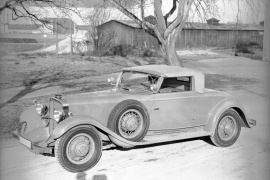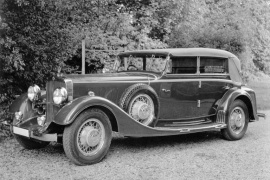MAYBACH Typ W6, W6 DSG and DSH Models/Series Timeline, Specifications & Photos
First production year: 1931
Engines: Gasoline
In 1929, Wilhelm Maybach passed away and left the carmaker without the main leader that the company needed. His son, Karl Maybach, tried to pick up the pace and prevent the brand from crumbling to the ground.
One of its first ideas was creating the W6 lineup, which mixed a new platform and the old inline-six engines. Moreover, the carmaker thought about developing a sportier version of the big car, addressed to the younger generation that emerged even wealthier after the world economic crisis in the early '30s. Thus, Karl Maybach introduced the W6 Sport Cabriolet. A model that was not as successful as he hoped for.
The car's front fascia resembled the same design language as its bigger, more luxurious siblings. It sported a front bumper attached to the chassis' endings in front of the front wheels. The pushed-back vertical radiator was partially protected by a curved cross-beam that also supported the headlights, and it was attached to the front fenders. Unlike the big sedans, the W6 Sport-Cabriolet featured a smaller, slightly tilted windscreen. There were only two rear-hinged doors. The retractable soft top couldn't be left at home and was stored behind the cockpit. At the back, the curved, sloped-down rear end concealed the trunk.
Like any other Maybach, the car's interior was garnished with expensive leather and wood grains on the dashboard. This version of the W6 offered just two seats. Karl Maybach made the car for those who wanted a car for their passion, not especially for business meetings and authorities.
Under the hood, the carmaker placed the former seven-liter inline-six powerplant. The standard version featured a three-speed gearbox. Later on, the DSG version added a semi-automatic one, with a two-speed transfer case that raised the total number of available gears to six.
After the company's founder passed away in 1929, his son Karl followed as CEO and kept the brand alive during the Great Depression years, and in 1934 introduced the Typ W6.
The name DSH came from the "Dopple-Sechs Halbe" (Double Six Half), meaning that the engine came from the former V12 but cut in half. So it was an inline-six under the car's hood, but the bodywork was still fit for a luxurious vehicle. It wasn't just large but also luxurious. Maybach built about 50 units of this W6 DSH and offered them either as finished products or as rolling chassis.
At the time of its launch, the Typ W6 was one of the longest on the market. Its headlights were mounted on a curved cross-beam supported by oversized, curved front fenders. The radiator was surrounded by a chromed trim, matching the supporting bar and the bumper. Since Maybach used to be an aviation company, its engineers knew a thing or two about aerodynamics, and they tilted the windshield to decrease the drag coefficient. Even though it was a closed-bodywork construction, the automaker offered an option for a retractable canvas top.
Under the hood, the carmaker installed an inline-six engine. It was not exactly half of the 7 or 8-liter V12 since it provided a 5.2-liter displacement. Moreover, it offered more than half the power of a Maybach V12, and since it was paired with a four-speed sequential gearbox, it got similar performances as the Typ 12.
After the company's founder, Wilhelm Maybach, passed away in 1929, his son, Karl, took the lead, and he faced the challenging times of the Great Depression during the early '30s when he tried to provide luxurious vehicles but at a lower cost.
Built with a choice of closed or open bodies or even a chassis-only, the DSH lineup was not as successful as Karl Maybach had hoped for. And yet, the carmaker managed to sell about 50 of them.
The DSH Cabriolet was a larger car than the W5 lineup it replaced, featuring a longer wheelbase and enhanced bodywork. Just like Mercedes-Benz, it mounted the headlights on a curved cross-beam supported by oversized, curved front fenders. The radiator was surrounded by a chromed trim, matching the supporting bar and the bumper. Since Maybach used to be an aviation company, its engineers knew a thing or two about aerodynamics, and they tilted the windshield to decrease the drag coefficient. The convertible sported four doors, both of them hinged on the B-pillar. At the back, behind the passenger area, Maybach installed an external trunk.
Maybach installed a luxurious cabin fitted with leather upholstery and expensive wood trims on the dashboard and door cards. Moreover, a handlebar was mounted at the back of the front seat's seatbacks so the rear occupants could egress more easily. Strangely, though, the side windows were not retractable but removable with their rim.
Under the hood, the carmaker installed an inline-six engine. It was not exactly half of the 7 or 8-liter V12 since it provided a 5.2-liter displacement. Moreover, it offered more than half the power of a Maybach V12, and since it was paired with a four-speed sequential gearbox, it got similar performances as the Typ 12 Cabriolet.
Two years after the company founder passed away, his son understood that building expensive cars won't make them survive on the market, and he made the W6 model.
Wilhelm Maybach lived a long life, and, in 1929, at the age of 83, he passed away after short, two-day suffering. Karl Maybach, his son, was committed to continuing his father's legacy. The company was already produced the DS7. The initials came from the Doppel-Sechs (Double-Six), which designated the V12 engines well known for their smoothness. But the car was very expensive to build, and its sticker price was high enough, so just a few could afford one. Karl Maybach had the idea to offer the already known DS7 with an inline-six engine, which was half of the ones installed in the DS series. The result was named W6.
At the front, the W6 featured a chromed bar between the long wheel-arches that supported the big headlights. Its slightly pinned-out radiator with vertical slats was pushed far behind so it would be protected in the event of a crash. Since the car's engine compartment was long, it allowed the carmaker to install two spare wheels on each side.
Inside, the leather and wood-trims were blended in a harmonious way dictated by the German luxury brand. There was more room in the back than on the front seats. It was a car where the owner was usually driven around by a chauffeur. But the car had limited success. According to some sources, Maybach produced only 40 W6 units, and most of them were lost during WWII.
Karl Maybach faced the difficulty of continuing his father's legacy after Wilhelm Maybach passed away in 1929, and the first model built after the tragic event was the W6 lineup.
In the late 20's it was much easier to make a convertible since all the cars featured a body-on-frame construction. Selling them was a different story. But Karl Maybach already had the network and the brand image to do that. He had the idea to produce an entry-level for the brand, creating the W6 lineup. The company already made the DS7, which featured a V-12 engine, but it was costly. With the new model, he tried to get more customers and offered a Maybach-quality vehicle with an inline-six powerplant under the hood.
At the front, the W6 featured a chromed bar between the long wheel-arches that supported the big headlights. Its slightly pinned-out radiator with vertical slats was pushed far behind the bumper, above the front axle. Since the car's engine compartment was long, it allowed the carmaker to install two spare wheels on each side. For the open-top version, Maybach offered a unique system that allowed full or partial opening.
Inside, the leather and wood trims blended harmoniously. There was more room in the back than on the front seats. It was a car where the owner was usually driven around by a chauffeur. Just two years after the launch of the new model, the world economic crisis struck, and the carmaker lost most of its customers, and those who aimed for a Maybach sought the top-spec version.




